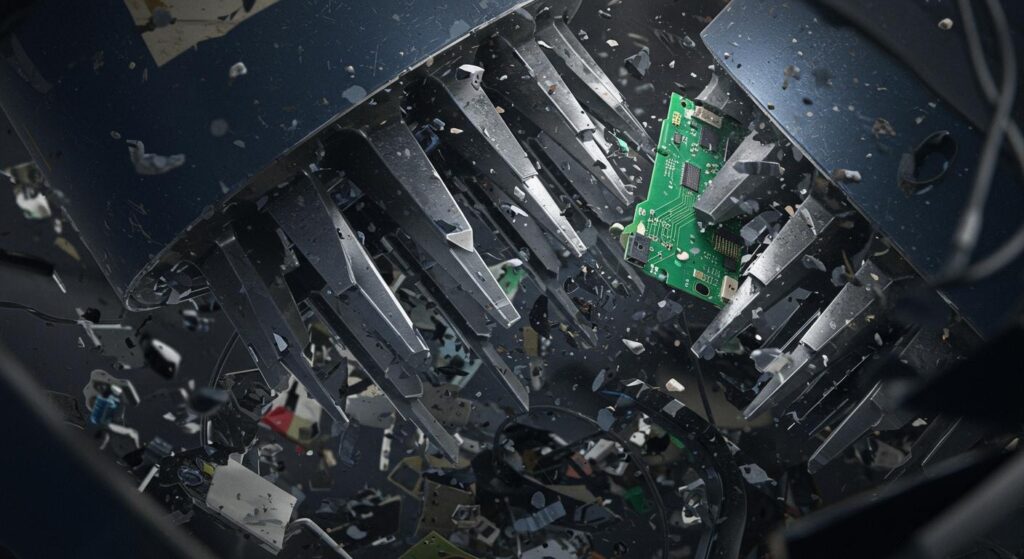
You have more problems when you try to handle e-waste safely. If you throw away e-waste the wrong way, it can leak private data. It can also hurt the earth. Good 전자 폐기물 슈레더 블레이드 help you follow safety rules. They also help you meet laws about e-waste. In 2021, people made 57.4 million tons of e-waste. Only 17.4% of it got recycled. Look at the recycling rates below:
| Region | Recycling Rate |
|---|---|
| 글로벌 | 17.4% |
| 유럽 | 42.5% |
| Asia | 11.7% |
| Africa | 0.9% |
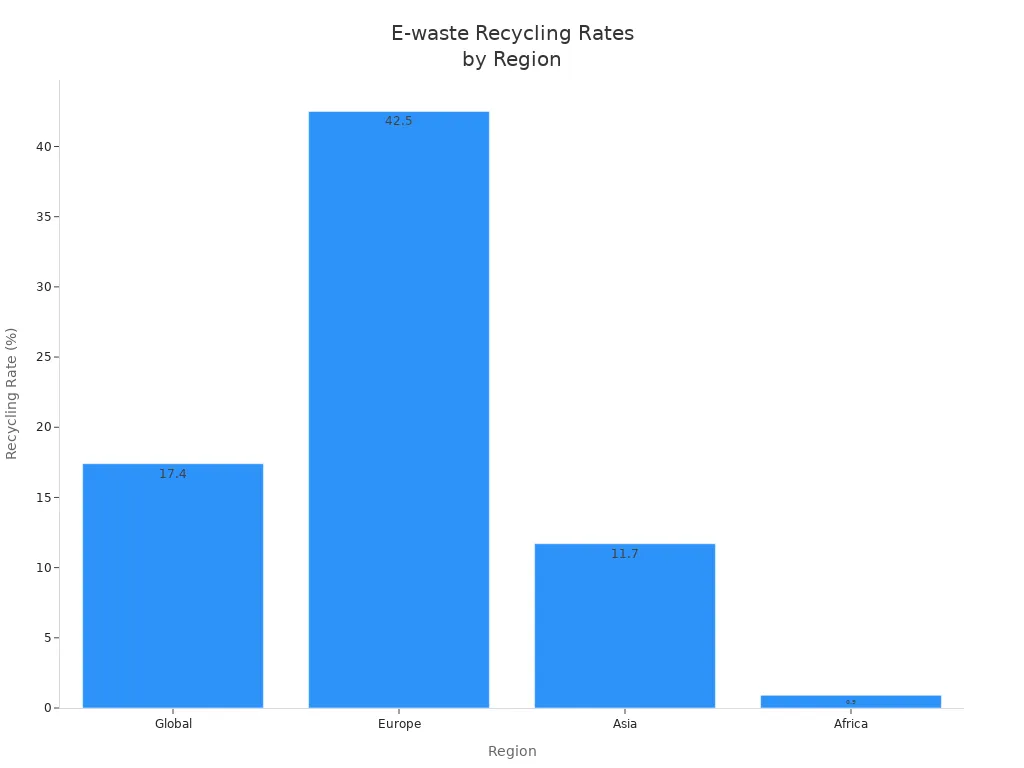
주요 요점
- E-waste shredders help destroy old electronics safely. They keep private data safe.
- Good shredder blades are made from strong materials. This makes e-waste processing work well and stay safe.
- There are different blade designs. Single-shaft and multi-shaft blades work for different e-waste types. These designs help shredders work better.
- Checking shredder blades often is important. It helps find worn blades and stops problems before they happen.
- Shredders have safety features. Auto-stop and enclosed systems keep workers safe. These features also help follow rules.
- Some blades can be changed to fit specific needs. Custom blades help shredders work better for each job.
- Good shredding helps recycle more e-waste. It also helps get back useful materials.
- Buying better blade technology saves money. It also helps shredders work faster and better.
E-waste Shredders and Secure Destruction

Why E-waste Security Matters
If you do not destroy e-waste the right way, you face many dangers. Old computers and phones can still have private data inside. Someone could find this data and use it to do bad things. Here is a table that lists the main dangers of not throwing away e-waste the right way:
| Risk Type | 설명 |
|---|---|
| Identity Theft | Old devices can store sensitive personal information, leading to unauthorized financial transactions. |
| Privacy Invasion | Improper disposal can expose private data, resulting in personal humiliation or extortion. |
| Financial Fraud | Malicious actors can retrieve banking details, leading to unauthorized withdrawals and financial strain. |
| Intellectual Property Theft | Discarded corporate devices may contain proprietary data, risking competitive advantage. |
| Regulatory Fines | Non-compliance with data privacy laws can lead to hefty fines and legal action. |
| Reputational Damage | Data breaches can tarnish a company’s reputation, leading to loss of trust and customer loyalty. |
| Operational Disruption | Recoverable data can lead to system infiltration, causing operational downtime and financial losses. |
| Employee Data Exposure | Improper disposal risks exposing sensitive employee information, leading to identity theft. |
You need to keep your business and your customers safe. E-waste shredders break devices so no one can get the data back. Using the right shredder lowers the chance of leaks and big fines. It also shows your customers that you care about their privacy.
How E-waste Shredder Blades Work
E-waste shredders cut electronics into tiny pieces. You put the device in the shredder. The blades slice and rip the parts until nothing can be put back together. Blade sharpness and strength help make this job quick and safe.
There are different kinds of e-waste shredders. Some have one shaft, and others have more than one. Each kind works best for certain things. Good e-waste shredders have strong blades, cut well, and can handle many types of e-waste.
Blade quality and design are very important. Strong blades last longer and cut better. A good design helps the shredder work faster and makes sure every part gets destroyed. If you use weak blades, you might leave data behind or slow down your work.
You also need to follow the rules for your industry. These rules keep you safe and help you avoid trouble with the law. Here are some important certifications and standards for safe e-waste destruction:
| 인증 | 설명 |
|---|---|
| e-Stewards | Ensures proper handling of sensitive materials and adherence to environmental standards. |
| ISO 14001 | Focuses on effective environmental management systems. |
| NAID AAA | Guarantees best practices in data security for shredding services. |
Tip: You should also learn about NIST 800-88, DoD guidelines, GDPR, and HIPAA. These set rules for destroying data and keeping it private.
When you pick the right e-waste shredder and use good blades, you protect your data and follow the law. This keeps your business safe and helps your clients trust you.
Key Features of E-waste Shredder Blades
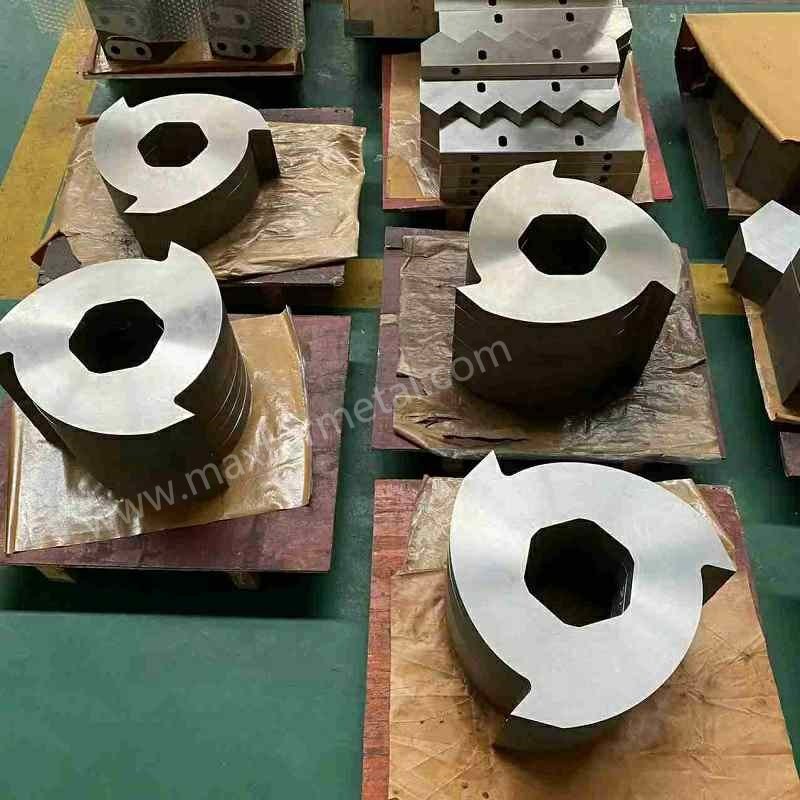
Material Durability
Importance of High-Grade Materials
E-waste shredder blades need to be strong for daily use. High-grade materials help the blades last longer and work better. Strong blades break less often and keep e-waste safe. Durable blades save you money because you do not replace them a lot. Using the right materials in waste management gives you better results and safer work.
Examples of Advanced Alloys and Steels
Many shredders use special metals to make blades tough. Here is a table that shows what materials are used and how strong they are:
| 재료 유형 | Durability Rating | 응용 |
|---|---|---|
| 합금강 | 높은 | Medium-hard materials like plastics and tires |
| 공구강 | 매우 높음 | Hard materials such as metal and glass |
| 텅스텐 카바이드 | 매우 높음 | Highly abrasive materials like fiberglass and minerals |
| 탄소강 | 보통의 | Light-duty operations with less demanding materials |
Alloy steel and tool steel make blades extra hard and tough. These materials help blades handle rough jobs and high stress. Blades last longer and you spend less on new ones. If you want to learn more about 커스텀 블레이드 materials, visit the custom blades page.
- Advanced alloys and steels make blades harder and tougher.
- These features help shredders work well with heavy and rough e-waste.
- Stronger materials mean blades last longer and cost less to replace.
Nanjing Metal Industrial’s Use of Premium Steel
난징 Metal 산업 uses high-quality steel for its shredder blades. The company picks strong steel so blades can handle tough e-waste jobs. Special machining and forging help blades stay sharp and strong. You get blades that work well, even in busy shredders. The company also makes custom blades, so you can get what you need.
절단 효율성
Precision Machining for Optimal Performance
Cutting efficiency is important when shredding e-waste. Precision machining gives each blade the right shape and size. This helps shredders cut electronics fast and safely. Well-made blades give smooth cuts and less downtime. You also keep data safe by making sure all e-waste is destroyed.
Here are some important things for cutting efficiency:
| Metric Type | 설명 |
|---|---|
| 블레이드 형상 | Influences cutting performance and efficiency; optimal shapes reduce cutting forces and improve load distribution. |
| 절단 각도 | Affects cutting forces and wear; moderate angles (30-60°) balance sharpness and durability. |
| Edge Count | Optimal number of edges enhances efficiency; too many can lead to performance degradation. |
| 블레이드 두께 | Must withstand bending moments while concentrating shear stress for effective cutting. |
| Bevel Geometry | Enhancements like serrated teeth improve material engagement and reduce slippage. |
| Configuration | Well-spaced cutting edges deliver effective shear forces, synchronized with feed characteristics. |
Impact on Shredding Speed and Particle Size
Blade shape changes how fast shredders work and how small the pieces get. The right design helps destroy devices quickly and keeps data safe. Look at the table below to see how different things affect shredding speed and particle size:
| 요인 | Impact on Shredding Speed and Particle Size |
|---|---|
| Cutter Radius/Diameter | Affects cutting force; smaller radius increases force, enhancing shredding speed. |
| Hook Height | Influences pressure and surface area; shorter hooks provide better shearing, affecting particle size. |
| Cutter Configuration | The arrangement and number of hooks impact the efficiency of force application, affecting throughput. |
Choosing the right blade shape gives you faster shredding and smaller pieces. This helps you meet safety rules and makes shredders work better.
Claw Design and Custom Blade Geometry
Claw designs and custom blade shapes help shredders handle different e-waste. Multi-shaft shredders with 3, 8, or 12-claw blades can break big and tough items. Custom blade shapes let you pick what works best for your needs. To learn more about custom options, visit the 커스텀 블레이드 페이지. The right design helps blades work better and last longer.
내마모성
Surface Treatments and Hardening Processes
Wear resistance is important for shredder blades. Special treatments make blades last longer and work better. Here are some common treatments:
| Surface Treatment Type | 설명 |
|---|---|
| Laser Strengthening | Melting treatment that creates a new surface layer by rapidly solidifying molten metal under laser. |
| 텅스텐 카바이드 코팅 | A coating that enhances wear resistance, typically applied in a thickness of 1.2-1.8mm. |
| Diamond-Like Carbon Coating | A thin coating (5-8μm) that provides excellent wear resistance and durability. |
| Laser-Clad Tungsten Carbide | A robust coating that significantly improves the wear resistance of shredder blades. |
These treatments help blades resist damage from hard and rough e-waste. You get more use from each blade and fewer stops for repairs.
Longevity in High-Volume Operations
If you shred a lot of e-waste, you need blades that last. Wear-resistant coatings and hardening keep blades sharp and strong. This means shredders run longer without stopping. You keep your work going and save money.
Benefits of Advanced Forging Techniques
Advanced forging makes shredder blades even stronger. Forging shapes metal under high pressure and makes blades tough. This process helps blades resist cracks and chips. Forged blades can handle tough e-waste and last a long time.
Tip: Pick blades with the right materials, design, and treatments. This helps shredders work better, saves money, and keeps your e-waste safe.
Blade Configuration
Single-Shaft vs. Multi-Shaft Arrangements
Picking the right blade setup is important for shredders. The way blades are arranged changes how well you can shred things. Here is a quick look at the differences:
- Single-Shaft Shredders
- These shredders can process a lot of material quickly.
- They work with many things, like big plastic containers and boxes.
- You can use a screen to pick the size of the pieces.
- Dual-Shaft Shredders
- These shredders have strong power for tough or dirty waste.
- They move slowly but can break down heavy items.
- They are good for shredding e-waste, plastic, and tires.
Multi-shaft shredders, like double or four-shaft types, give you more choices. You can shred many kinds of e-waste, such as circuit boards and cables. The best setup helps you work faster and reach your waste goals.
Customization for Different E-waste Streams
Every e-waste stream is not the same. You need blades that fit what you are shredding. Customizing lets you change blade types, speeds, and setups for better results. Here is a table with common ways to customize:
| 사용자 정의 옵션 | 설명 |
|---|---|
| Variable Speed Controls | Lets you change how fast you shred different e-waste. |
| Customizable Blade Configurations | You can set up blades to shred certain electronics better. |
Custom blades help you shred small gadgets and big appliances.
OEM/ODM Services by Nanjing Metal Industrial
Sometimes you need a special blade for your shredder. 난징 Metal Industrial gives OEM and ODM services. You can talk to their team to make blades that fit your needs. They use special machines and forging to make strong blades. You get blades that work well for your e-waste jobs.
Safety Mechanisms
Built-in Safety Features (e.g., Auto-Stop, Enclosed Systems)
Modern e-waste shredders have safety features to keep you safe. These features protect workers while shredding. Here is a table of common safety features:
| 안전 기능 | 설명 |
|---|---|
| Interlocks | Stops the shredder if a door is open. |
| 비상 정지 버튼 | Lets you turn off the shredder fast in danger. |
| Enclosed Cutting Chambers | Keeps moving parts covered to stop injuries. |
| Overload Protection Systems | Stops damage and keeps shredding safe. |
| Dust-Control Systems | Lowers the risk from harmful dust. |
These features help you keep your workplace safe when shredding e-waste.
Operator Protection and Anti-jam Technology
You need to keep workers safe and stop jams. Anti-jam tech controls how much material goes into the blades. If a jam happens, the shredder can fix itself. This means you do not have to stop and fix jams by hand. You spend more time shredding and less time fixing. Workers stay safer, and machines last longer.
Compliance with Industry Safety Standards
You must follow safety rules when working with e-waste. Things like interlocks, emergency stops, and dust-control help you follow these rules. Following the rules keeps your team and business safe. It also shows you care about safe waste management.
E-waste Shredder Blade Design
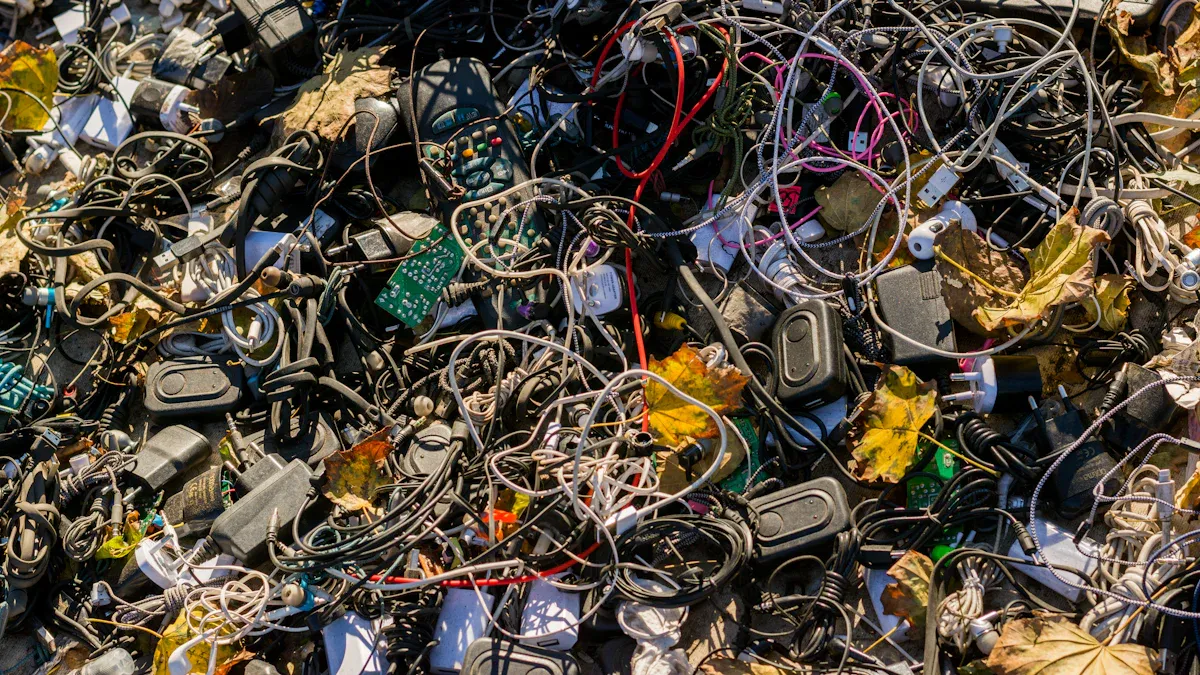
The way shredder blades are made changes how well you can break down e-waste. It also affects how much valuable material you can get back. You must pick the right blade type and pattern for your job. This choice changes how fast and well the shredder works. It also changes how much good material you can recover. Let’s see the main blade designs and how they help with different e-waste.
Single-Shaft vs. Multi-Shaft
Single-Shaft Shredders
Single-shaft shredders have one spinning shaft with blades on it. You put e-waste in, and the shaft pulls it inside. The blades cut the waste against a fixed blade. You can change the screen to pick the size of the pieces.
장점
- You get even cuts and same-size pieces.
- Fewer moving parts make fixing easier.
- These shredders use less power than multi-shaft ones.
- They can shred many kinds of e-waste, like PCBs, wires, batteries, and hard drives.
단점
- Single-shaft shredders may not break very tough or big items as well as multi-shaft ones.
- They can be slower when shredding lots of heavy metal.
일반적인 응용 프로그램
You use single-shaft shredders for softer or medium-hard e-waste. These include plastic cases, cables, and small electronics. They are good for recycling centers that take apart electronics and destroy data.
Multi-Shaft Shredders
Multi-shaft shredders, like dual-shaft or four-shaft types, have two or more shafts with blades that fit together. The shafts spin in opposite ways. This design rips and crushes tough things.
장점
- You can shred very tough and big e-waste, like metal frames and large appliances.
- The design can handle mixed materials and tricky parts.
- Multi-shaft shredders can shred a lot and do heavy jobs.
단점
- These shredders need more power and are harder to fix.
- The pieces may not all be the same size as with single-shaft models.
일반적인 응용 프로그램
You use multi-shaft shredders for big or tough e-waste. These include bulky metals, mixed electronics, and things with both metal and plastic. They are used where you need to shred lots of e-waste fast.
Here is a table that shows which shredder works best for each e-waste type:
| 분쇄기 유형 | Best Processed Materials | 주요 특징 |
|---|---|---|
| 단일 샤프트 분쇄기 | PCBs, plastic casings, wires, batteries, hard drives | Precision cutting, lower energy use, easier maintenance |
| Dual-Shaft Shredder | Bulky metals, tough materials | Higher power demand, more complex maintenance |
Tip: Pick the shredder type that matches the e-waste you have most. This helps you work faster and get more good material back.
Tooth Patterns
Overview of Common Tooth Patterns
Blade tooth patterns change how shredders cut e-waste. There are a few common types:
- Straight Teeth: These teeth cut clean and work best for plastics and soft things.
- Claw Teeth: These have sharp tips that grab and rip tough or big items, like metal frames or cables.
- Serrated Teeth: These have jagged edges that help shred stringy or layered stuff.
Comparative Analysis of Tooth Patterns
Each tooth pattern works best for certain e-waste. Here is a table to compare them:
| Tooth Pattern | 가장 적합한 | Cutting Action | 일반적인 사용 사례 |
|---|---|---|---|
| 똑바로 | Plastics, circuit boards | Clean slicing | Small electronics, PCBs |
| Claw | Bulky metals, cables | Gripping and tearing | Appliances, mixed e-waste |
| 톱니 모양의 | Fibrous or layered materials | Sawing and shredding | Wire bundles, composite parts |
You can pick the pattern that fits your material. This helps the shredder work better and lets you get more valuable stuff out.
Impact on Shredding Efficiency and Material Types
The right tooth pattern lets you shred e-waste faster and keeps blades from wearing out too soon. For example, claw teeth help you shred big, tough things without jams. Straight teeth give smooth cuts for plastics and circuit boards. Serrated teeth are best for cables and layered things. By matching the tooth pattern to your e-waste, you can shred more and stop less.
사용자 정의 옵션
Sometimes you need special blade designs for tricky e-waste. Custom blades let you change the shape, material, and tooth pattern to fit your needs. Top companies, like Nanjing Metal Industrial, have many custom blade choices and OEM/ODM services.
Here is a table that shows what you can change:
| 사용자 정의 측면 | 세부 |
|---|---|
| 사용된 재료 | Carburizing steel, tool steel, chromium, molybdenum, manganese low alloy steels, Hardox® steels. |
| 제조 공정 | High precision CNC manufacturing, heat treatment processes including carburizing and quenching. |
| Applications Supported | WEEE recycling, plastic and rubber recycling, paper and cardboard recycling, tires, household waste. |
| Customization Experience | Many years of experience advising on optimal steel and blade shape for toughness and hardness. |
You get many good things from custom blades:
- You can set up shredders for special e-waste, like circuit boards, cables, and plastics.
- Changing blade shape and material makes cutting better and blades last longer.
- Better designs help you get more valuable material from e-waste.
- Custom blades help you follow strict rules for waste management.
메모: More and more electronics are thrown away every year. Shredder knives are now made for tricky e-waste parts. New rules make recyclers buy better shredders.
Nanjing Metal Industrial can help you with many blade types and OEM/ODM services. You can work with their team to make blades that fit your job.
유지 관리 및 수명
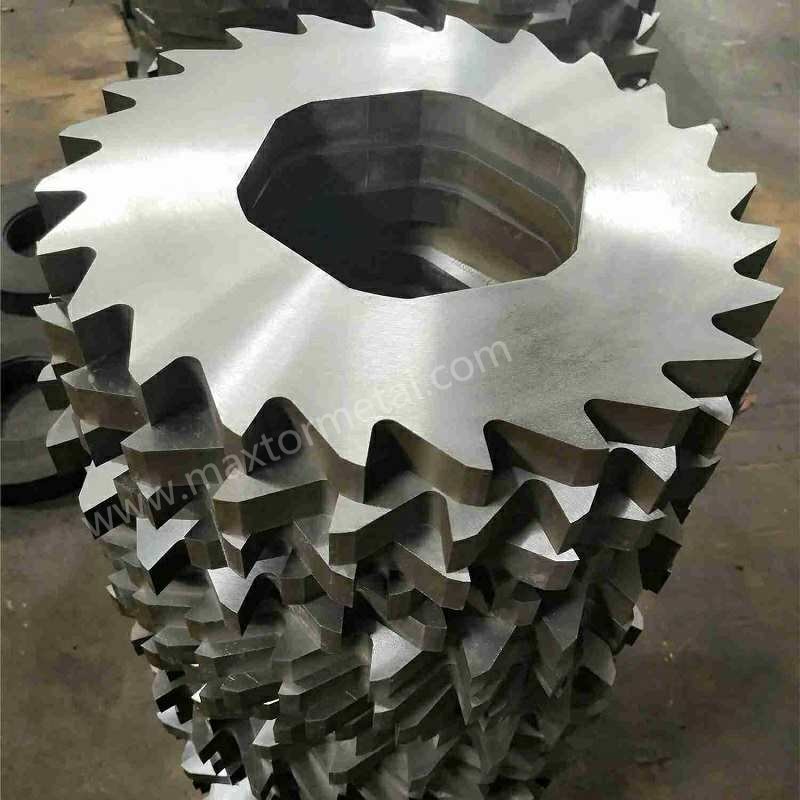
Taking care of your e-waste shredders helps them last longer. Good maintenance keeps your machines working well and safe. You can stop problems and save money by checking your shredder often. Let’s see how you can spot blade wear, clean and check your blades, and change them safely.
Wear Indicators
블레이드 마모의 일반적인 징후
You should look for signs that your shredder blades are getting old. Some things you might see are:
- Chips or cracks on the blade edges
- Corners that look round, not sharp
- Dark spots or burn marks on the blade
- Shredded e-waste with rough or uneven cuts
- The shredder makes more noise or shakes more
If you notice these things, your blades may not work well anymore.
Methods for Detecting Wear
There are different ways to check if your blades are worn out. Each way has its own good points. The table below shows some ways to find blade wear and how well they work:
| Detection Method | Indicators / Description | Accuracy / Reliability | Efficiency / Practicality |
|---|---|---|---|
| 시각 검사 | Look for chips, cracks, rounded corners, dark spots, burn marks under bright light or magnifying glass | Reliable for spotting physical blade damage | Quick and easy for routine checks |
| Operational Signs | Increased power use, slower cutting, uneven cuts, overheating, loud noises, vibrations | Good indicator of blade dullness during use | Efficient as it uses normal machine data |
| Borg Scale Measurement | Measures cutting effort; dull blades score higher; strong link to sharpness | High accuracy and correlation with sharpness | Needs special tools but very precise |
| Vibration Sensors & AI | Sensors track early wear; AI predicts when to replace blades | Early and precise detection | Needs investment in equipment and setup |
You can start with easy checks and use better tools as your business grows.
Practical Examples of Wear in E-waste Shredder Blades
Think about running a busy e-waste recycling center. Your shredder gets louder and the pieces come out rough. When you look at the blades, you see small chips and dark spots. These are signs the blades are wearing out. If you do not fix this, your shredder could break or not shred safely. Checking often helps you find problems early.
Cleaning and Inspection
Recommended Maintenance Schedule
You should follow a regular plan to keep your shredder blades in good shape:
- Get professional maintenance every 6 months if you shred a lot.
- Do yearly maintenance for normal shredders.
- Fix problems right away if you see changes in how it works.
- Check and clean blades after big jams or machine trouble.
Following this plan helps you stop bigger problems later.
Tools and Products for Effective Cleaning
Cleaning your blades helps them stay sharp and work well. Here are some things you should use:
- A soft brush or cloth to wipe off dirt from the blades
- Compressed air or canned air to blow away small bits
- Use canned air every two weeks to clean the cutting parts and sensors
Cleaning often makes your shredder last longer and work better.
Inspection Checklist for Blade Condition
You can use this checklist to look at your shredder blades:
- Look for chips, cracks, or round corners on the blade
- Check for dark spots or burn marks
- Make sure the blade is sharp, not dull
- Listen for strange noises or shaking when running
- Look for rough or uneven cuts in shredded e-waste
- Check the main shaft and flange for dirt or damage
Tip: Write down each inspection. This helps you see patterns and know when to replace blades.
교체 지침
Step-by-Step Blade Replacement Process
When you need to change your shredder blades, follow these steps to stay safe:
- Protect the alloy tips so they do not get damaged.
- Check the main shaft to make sure the blade lines up right.
- Clean the main shaft and flange before putting on the new blade. The flange should be flat, clean, and at a right angle to the shaft.
- Use the biggest flange you can. For thin blades, use a flange half the blade’s size. This keeps the blade steady.
- After putting on the blade, let it spin for 30 seconds. Make sure it works before shredding.
- Tighten the flange nuts well. This stops the blade from slipping or breaking the shredder.
- Always wear safety glasses, dust masks, helmets, and gloves. Make sure the shredder’s guard is in place.
Safety first! Always use safety gear and check everything before you start.
Key Safety Precautions and Best Practices
You should always put safety first when working with shredders. Here are some good rules:
- Turn off and unplug the shredder before any work.
- Wear all the safety gear you need.
- Check that all guards and covers are on before starting.
- Keep your work area clean and free of tools or trash.
Doing these things helps stop accidents and keeps everyone safe.
Advanced Forging and Heat Treatment Benefits
Advanced forging and heat treatment make shredder blades last longer. Forging makes the steel stronger and removes weak spots. This helps the blade stay strong and stable. Heat treatment, like vacuum or salt bath, keeps the blade from bending and makes it hard all over. The table below shows how these help:
| 증거 설명 | 핵심 포인트 |
|---|---|
| Advanced forging improves steel quality | Enhances microstructure, removes loose metal, increases mechanical stability |
| Heat treatment methods used | Vacuum and salt bath methods ensure uniformity, prevent deformation, maintain high quality results |
When you pick blades made this way, they last longer and work better. This means you do not have to replace them as much and your shredder works well for e-waste jobs.
Safety and Compliance in E-waste Shredders
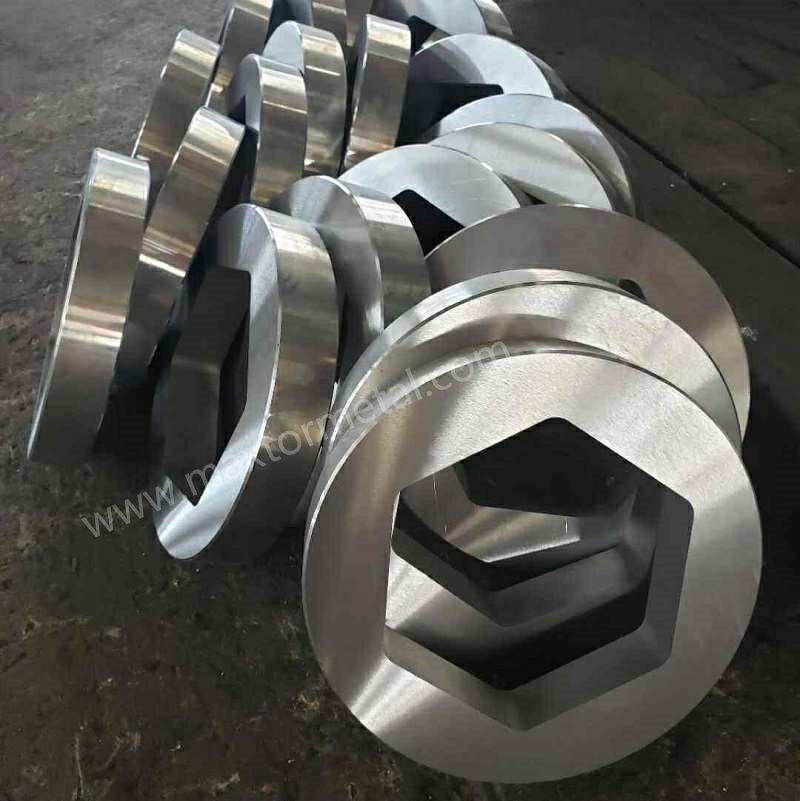
When you use e-waste shredders, safety is very important. You must also follow the rules for your job. These machines can be risky if you do not use them right. Safety features help keep people safe. You need to make sure your shredding meets the rules. This keeps workers safe and your business legal. It also makes sure data is destroyed.
Operator Protection
Working with e-waste can be dangerous. Heavy metals can make you sick. Bad fumes can hurt your lungs. Sharp pieces can cut you. You need to wear the right gear and use safe habits.
- Gloves keep your hands safe from sharp metal.
- Safety goggles protect your eyes from flying bits.
- A conti-suit keeps your skin safe from bad fumes.
- Safety boots with steel toes protect your feet from heavy things.
- Masks help you not breathe in bad air.
- Hearing protection is needed when it is loud.
- A visibility vest helps others see you.
Always use guards and shields on your shredder. These stop pieces from flying out and hurting you. Emergency stop buttons let you turn off the shredder fast if needed. You must get training and wear your safety gear every time you work.
Tip: Check your shredder often and keep it clean. This helps stop accidents before they happen.
Anti-jam Features
Jams can slow you down and cause danger. New e-waste shredders have anti-jam features to help. One good feature is auto-reversal. If the shredder gets stuck, the blades turn the other way. This clears the jam and keeps things safe.
| 특징 | 설명 |
|---|---|
| Auto-reversal | Turns blades backward to clear jams and stop overfeeding. |
| Reliability | Helps the shredder work longer without stopping. |
| Safety Mechanism | Stops damage from hard things and keeps users safe. |
Pick shredders with these features. They help you stay safe and keep your work moving.
Data Security
You must make sure no one can get data from old devices. E-waste shredders help destroy secret files and old tech. These machines cut hard drives and storage into tiny bits. This makes it impossible to get the data back.
- E-waste shredders make devices into very small pieces.
- This is safer than just erasing data.
- You can destroy all kinds of drives and media.
| Shred Size | 설명 |
|---|---|
| 2mm | Makes media into tiny bits so all data is gone from any drive or device. |
You must follow the rules for destroying data. This keeps your business safe and protects your clients. Always use shredders that meet the rules for safe data destruction.
Note: Using safety features and following the rules keeps workers safe, meets laws, and protects private data.
Value Recovery from E-waste
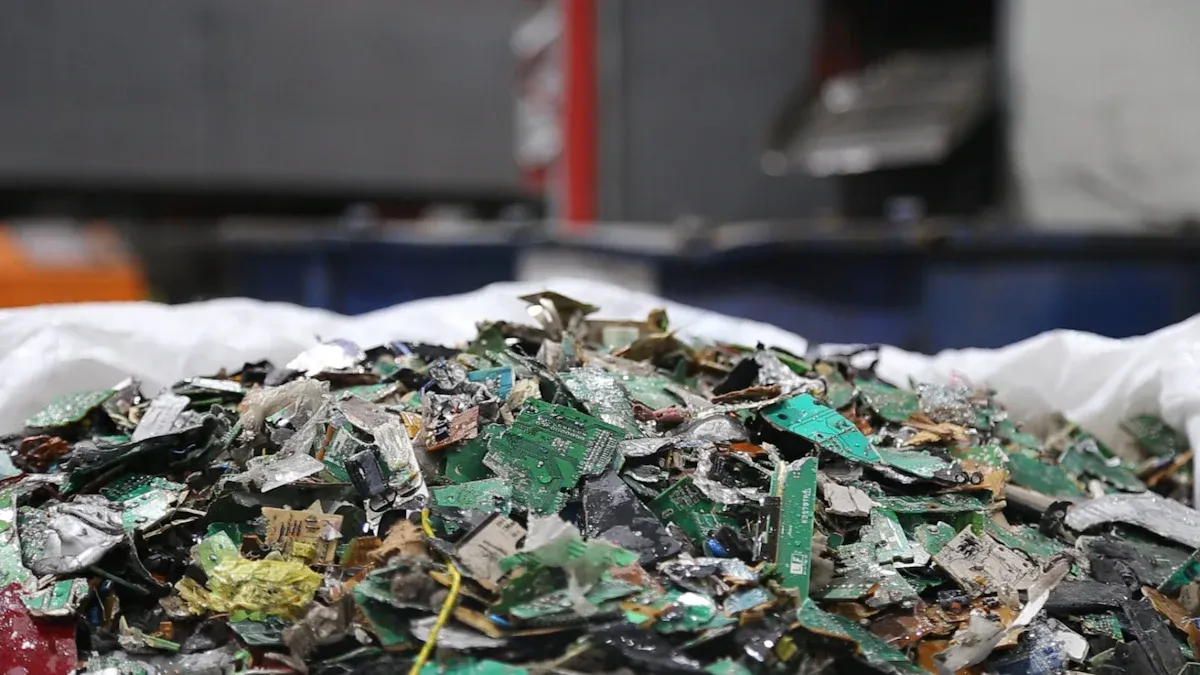
Material Separation
When you shred old electronics, it helps get valuable materials out. Shredding breaks big devices into small pieces. This makes it easier to separate metals, plastics, and other parts. It also gives recyclers a better way to sort copper, gold, and silver from the rest. These metals can be used again in new things.
Here is how the process goes:
| 단계 | 설명 |
|---|---|
| Shredding | Breaks big devices into small pieces for easier sorting. |
| Mechanical Processing | Makes it easier to get valuable materials by breaking things apart. |
| Advanced Technology | Uses special shredders to handle different e-waste types well. |
Shredding is the first step in the process. After shredding, machines use magnets, air, or water to pull out metals and plastics. This helps get more useful materials and keeps bad stuff out of landfills.
Tip: Good shredding helps recycling and lets us reuse important things.
Resource Efficiency
Blade design is important for getting more materials back. Sharp and strong blades cut electronics into even pieces. This makes sorting faster and easier. The right blade shape gives you smaller and cleaner pieces. These are easier to separate by type.
Getting more materials from e-waste helps the earth. Less trash goes to landfills. Making new metals from recycled ones uses less energy than mining. Here are some ways blade design helps save resources:
- Sharp blades make less dust and waste.
- Special tooth patterns cut tough parts, so you get more clean pieces.
- Custom blade shapes help with different electronics.
Picking the right shredder blades makes recycling work better. It also helps keep the planet clean by letting us use valuable materials again.
You need shredder blades that are strong and sharp. Good blades also help keep you safe when destroying e-waste. High-quality blades help you follow safety rules. They also help your work go smoothly. Check the shredder blades you use now. Better blades can help you shred e-waste better and keep your data safe. If you want help or special blades, visit the contact page.
자주 묻는 질문
What are e-waste shredder blades used for?
E-waste shredder blades break old electronics into small pieces. They help destroy devices so no one can get data back. Cutting things up also makes recycling much easier.
How often should you replace e-waste shredder blades?
Check your blades every month to see if they are damaged. Replace them if you find chips, cracks, or dull spots. Changing blades often keeps your shredder safe and working well.
What materials make the best e-waste shredder blades?
Tool steel and alloy steel make the best shredder blades. These metals stay sharp longer and do not wear out fast. Strong blades help you shred tough electronics without needing new ones often.
Can you customize e-waste shredder blades for different devices?
You can get custom blades made for special devices. Custom blades fit your needs, whether you shred small gadgets or big appliances. This helps your shredder work better for each job.
How do safety features protect you during shredding?
Safety features like closed chambers and emergency stop buttons keep you safe. These features help stop injuries and shut down the machine fast if something goes wrong.
Why is blade design important for secure data destruction?
Blade design helps destroy data by cutting devices into tiny bits. Sharp blades make sure no one can get information from old electronics.
What signs show that e-waste shredder blades need maintenance?
If you hear more noise or see rough cuts, your blades may need care. Blades that look chipped or dull should be cleaned, checked, or replaced soon.
Do e-waste shredder blades help with recycling?
Shredder blades help separate valuable parts from electronics. Cutting things into small pieces makes it easier to get metals and plastics for recycling.
또한 참조
산업용 분쇄기 블레이드 및 그 응용 분야에 대한 가이드
단일 샤프트 분쇄기 블레이드의 비밀 풀기: 유지 관리, 선택 및 문제 해결 가이드
분쇄기 블레이드: 분류, 재료 선택, 서비스 수명 및 설계 기술 분석

